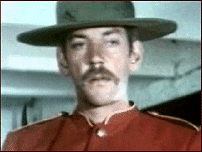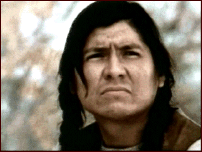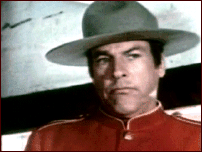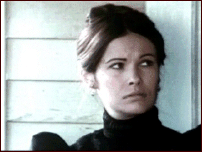Fri 24 Jul 2009
Western movie review: DAN CANDY’S LAW (1974).
Posted by Steve under Reviews , Western movies1 Comment
DAN CANDY’S LAW. American International Pictures, 1974; aka Alien Thunder. Donald Sutherland, Gordon Tootoosis, Chief Dan George, Kevin McCarthy, Francine Racette, Ernestine Gamble. Director: Claude Fournier.
Based on an actual historical incident, and seemingly filmed on a budget of no more than two or three thousand dollars, this small movie filmed on location in Saskatchewan, Canada, still packs a remarkable punch.

The movie, set in 1885, is based on the true story of a Cree Indian named Almighty Voice (Gordon Tootoosis), who after being arrested for killing one of the Queen’s cows, escapes from jail and kills the Mountie who goes after him.
Leading his pursuers a merry chase for over a year with the unspoken help of his fellow tribesmen, his primary nemesis is Constable Dan Candy (Donald Sutherland).
Filled with guilt for his laxness in allowing the prisoner to escape and for allowing his fellow officer (Kevin McCarthy, in a very brief role) to go out after him alone, Candy is obsessed with bringing Almighty Voice in, even to the extent of refusing orders and come back in by his commanding officer.

The ending is both quite a shocker and very poignant, as some truly heavy artillery is brought in, with a multitude of town folk and native people standing and watching quietly up along the skyline above. It’s authentic, it’s moving, and it’s painful to watch.
The setting is as authentic as in any western I’ve ever seen. It is as if someone with my father’s home movie camera in the 1940s went back in time and filmed the entire movie on location in grainy, faded color, complete with roughly constructed buildings with unpainted wooden shingles such as those I grew up seeing in my grandparents’ photo albums. I could swear that one of the children had a snowsuit on just like the one I had when I was six years old.

Donald Sutherland, already an established star, turns in a remarkable performance for a salary that must have been peanuts, even in 1974.
As a teller of tall tales, fully mustachioed, in one telling scene Dan Candy relates the son of the man who was killed a story about himself as a youngster and the privy his family had with a tar paper roof. In the summer when it got hot, birds would land on it and get stuck. After enough birds found themselves trapped on the roof, they all flew away with the outer building stuck to their feet and with his father still sitting there with his pants around his ankles, and that is how he remembers him, as he breaks down in tears.
Beware by all means, though, if it’s possible, of the DVD produced by Mill Creek Entertainment. Whoever did the transfer knew nothing about scan and pan or any other enhancement that might indicate any sense of professionalism in their chosen line of work. In close-up many faces are sliced in half or worse, and sound effects are often heard but have no appreciable visual connection with what’s seen on the screen.

The story line itself moves from scene to scene rather abruptly. I won’t blame the transfer guy for that, and once it’s gotten used to, it’s paradoxically as though the low grade production values only enhance the story.
I don’t think I can explain any further. All I can do is repeat myself by recycling much of what I’ve said already. In spite of its many flaws, whatever their causes, this is a movie that feels authentic, it’s moving, and if you stay with it, the ending is one that’s painful to watch — and all the more so because you know it’s one that’s coming.
January 11th, 2024 at 7:30 pm
Average movie which only intermittently comes to live. A good performance from Sutherland, and it’s always a delight to see Chief Dan George.
Not sure why they got Kevin McCarthy for such a small if pivitol role.
imdb trivia reminded me that the movie featured the lead actors of the original invasion of the body snatchers and it’s remake ie Mccarthy and Sutherland. McCarthy had a small role in the remake, playing the same character as in the original. His appearance is more brief than in this movie, but it’s a better one.